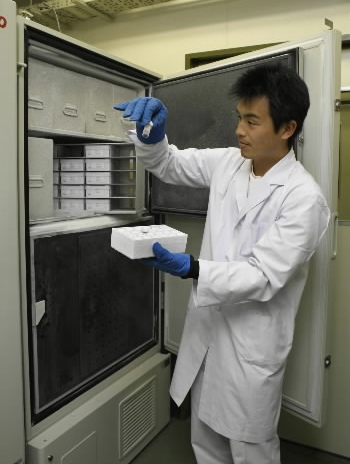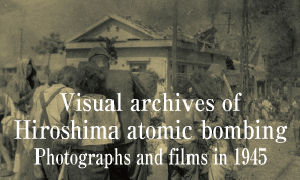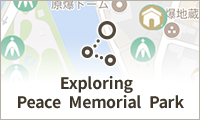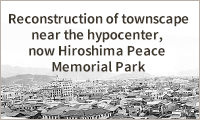Special Series: 60 Years of RERF, Part II [1]
Jun. 30, 2010
Second-generation A-bomb survivors: Researching genetic effects
by Masayoshi Ishikawa, Staff Writer
This feature series on the past and future of the Radiation Effects Research Foundation (RERF) originally began to appear in the Chugoku Shimbun in March 2007.
Seeking to transcend the "boundaries of human knowledge"
Does the parents' exposure to radiation affect the health of the children they bear? On February 28, the Radiation Effects Research Foundation (RERF) in Minami Ward, Hiroshima, announced the latest survey results on second-generation A-bomb survivors, based on health checkups of more than 10,000 second-generation subjects: "There is no significant statistical difference between second-generation A-bomb survivors and the children of non-A-bomb survivors (non-hibakusha)." However, these findings have not fully shed light on the genetic effects of radiation on the human body. Unless an absence of genetic effects can be confirmed, the concerns of second-generation A-bomb survivors cannot be dispelled. The Chugoku Shimbun will seek to illuminate the current situation involving second-generation A-bomb survivors, reflecting the development and the limits of RERF's research over the past 60 years.
"Pronouncing genetic effects to be either present or absent is a very difficult task," said Akio Awa, 74, the former chief of the Department of Genetics at RERF, in his Hiroshima apartment which overlooks the quiet water of Hiroshima Bay. The results of the survey on second-generation A-bomb survivors that were announced by RERF a few days later proved his words true.
"At this stage, there is no significant difference between second-generation A-bomb survivors and children of non-hibakusha with regard to the possibility of suffering from lifestyle-related diseases, or the risk of developing these diseases," RERF stated. Surveys targeted at second-generation A-bomb survivors have been conducted repeatedly since the survey on birth defects in newborn babies in Hiroshima and Nagasaki, which was undertaken by the Atomic Bomb Casualty Commission (ABCC), RERF's predecessor, in 1948. The latest survey on second-generation A-bomb survivors shows roughly the same results as previous surveys. The results of the latest survey also include the same conditional phrase that has accompanied previous results: "at this stage."
Forty years ago, Dr. Awa, who had been involved in the study of chromosomes at Hokkaido University, took up his post at ABCC. Soon, he heard sorrowful appeals from parents who had endured their A-bomb experiences and were blessed with children.
Through telephone consultations, the institute inquired about the condition of the survey subjects. The voices on the phone were shaking due to concerns over their children's health. The children easily caught colds or often had nosebleeds. Dr. Awa suggested to the parents, who were worried these issues involving their children's health might be because of their exposure to the atomic bombing, that the children undergo a chromosomal test. "When I showed them the test results, indicating that nothing abnormal was detected, they were overjoyed," Dr. Awa recalled.
Even when such determinations are made on an individual basis, the possibility of genetic effects in second-generation A-bomb survivors cannot be ruled out across the board. Modern medicine has, as yet, been unable to clarify exactly how radiation affects genes and the pathogenic mechanism.
Though this reality has made Dr. Awa painfully aware of the limits of science, he also said that he was "glad the effects of radiation have not been detected in second-generation hibakusha," in consideration of the significant social repercussions that would follow such a finding. This concern is felt by the current RERF leadership.
On February 28, when RERF announced the results of the latest survey on second-generation A-bomb survivors, the press repeatedly asked Dr. Toshiteru Okubo, the RERF chairman: "Are you saying there is no effect of parental exposure on second-generation A-bomb survivors?" Dr. Okubo's response was emphatic: "No, I'm not. Please do not remove the phrase 'at this stage'." After the news conference, he murmured, "It's terribly difficult to state positively that there is no effect."
The number of second-generation A-bomb survivors, according to RERF's analysis, totals about 77,000. Of this number, the institute has, for the first time, provided health checkups to 11,951 second-generation hibakusha who had hoped to receive them. But even the analysis of this clinical data does not enable the institute to confirm whether or not genetic effects exist, as the data has been influenced by individual lifestyle habits. At the same time, animal experiments have indeed determined the presence of genetic effects.
Dr. Awa also expressed frustration over these "boundaries of human knowledge." Still, he stressed, "This would never justify repeating the experiment of the atomic bombings."
The blood samples of 11,609 second-generation A-bomb survivors are now preserved at low temperature at RERF. Accompanying these samples is the strong wish of the second-generation A-bomb survivors to fully clarify the effects of radiation on the human body. Ninety-seven percent of those who underwent the health checkups have given their consent to have their samples preserved for the future.
"The institute must continue its research further. If the research were to stop, this would mean that the United States and Japan, the two nations involved in the atomic bombings, would have abandoned their responsibilities. This would be a disgrace to humanity as well." Dr. Awa, who continues to conduct research away from the institute, conveyed this message to his old workplace.
(Originally published on March 21, 2007)








